2009 KIA SOUL oil filter
[x] Cancel search: oil filterPage 260 of 328
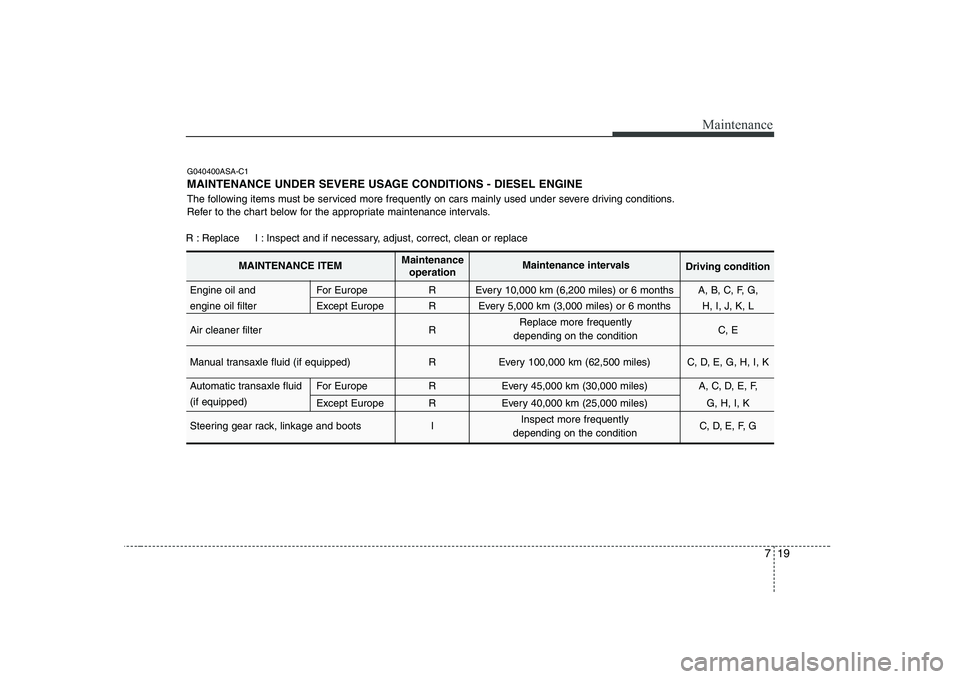
719
Maintenance
G040400ASA-C1
MAINTENANCE UNDER SEVERE USAGE CONDITIONS - DIESEL ENGINE
The following items must be serviced more frequently on cars mainly used under severe driving conditions.
Refer to the chart below for the appropriate maintenance intervals.
R : Replace I : Inspect and if necessary, adjust, correct, clean or replace
MAINTENANCE ITEMMaintenance
operation Maintenance intervals
Driving condition
Replace more frequently
depending on the condition
Engine oil and For Europe R Every 10,000 km (6,200 miles) or 6 months A, B, C, F, G,
engine oil filter Except Europe R Every 5,000 km (3,000 miles) or 6 months H, I, J, K, L
Air cleaner filter R
C, E
Manual transaxle fluid (if equipped) R Every 100,000 km (62,500 miles) C, D, E, G, H, I, K
Automatic transaxle fluid For Europe R Every 45,000 km (30,000 miles) A, C, D, E, F, (if equipped) Except Europe R Every 40,000 km (25,000 miles) G, H, I, K
Steering gear rack, linkage and boots I C, D, E, F, G
Inspect more frequently
depending on the condition
Page 262 of 328
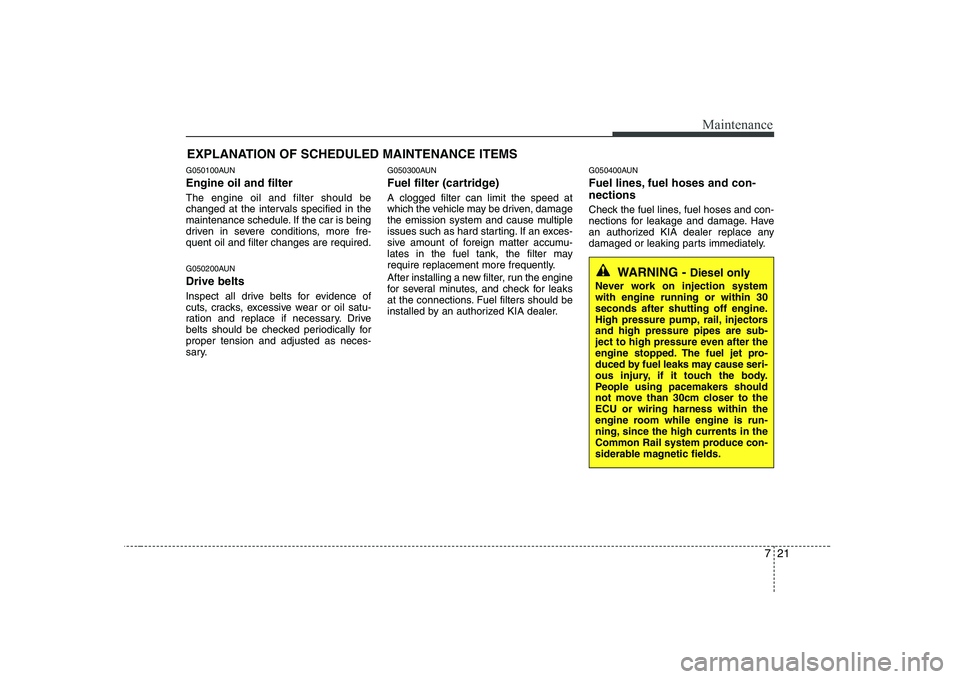
721
Maintenance
EXPLANATION OF SCHEDULED MAINTENANCE ITEMS
G050100AUN Engine oil and filter The engine oil and filter should be
changed at the intervals specified in the
maintenance schedule. If the car is being
driven in severe conditions, more fre-quent oil and filter changes are required.
G050200AUN Drive belts
Inspect all drive belts for evidence of
cuts, cracks, excessive wear or oil satu-
ration and replace if necessary. Drive
belts should be checked periodically forproper tension and adjusted as neces-
sary. G050300AUN
Fuel filter (cartridge) A clogged filter can limit the speed at
which the vehicle may be driven, damage
the emission system and cause multiple
issues such as hard starting. If an exces-
sive amount of foreign matter accumu-
lates in the fuel tank, the filter may
require replacement more frequently.
After installing a new filter, run the engine
for several minutes, and check for leaks
at the connections. Fuel filters should be
installed by an authorized KIA dealer.
G050400AUN
Fuel lines, fuel hoses and con- nections
Check the fuel lines, fuel hoses and con-
nections for leakage and damage. Have
an authorized KIA dealer replace any
damaged or leaking parts immediately.
WARNING -
Diesel only
Never work on injection system with engine running or within 30
seconds after shutting off engine.
High pressure pump, rail, injectorsand high pressure pipes are sub-
ject to high pressure even after the
engine stopped. The fuel jet pro-
duced by fuel leaks may cause seri-
ous injury, if it touch the body.
People using pacemakers should
not move than 30cm closer to theECU or wiring harness within the
engine room while engine is run-
ning, since the high currents in the
Common Rail system produce con-
siderable magnetic fields.
Page 267 of 328
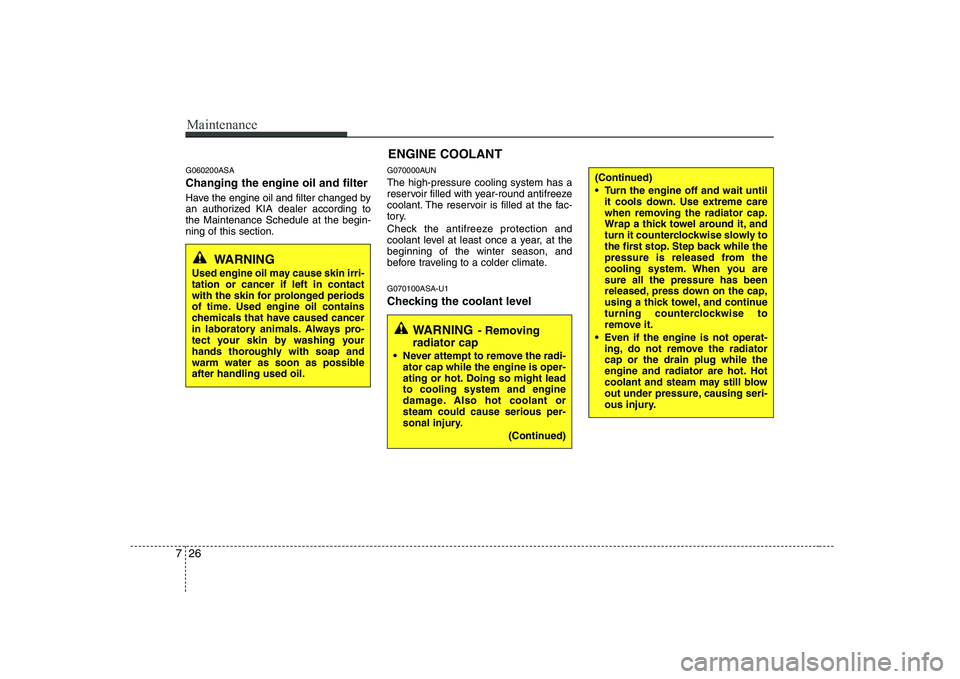
Maintenance
26
7
G060200ASA Changing the engine oil and filter
Have the engine oil and filter changed by
an authorized KIA dealer according tothe Maintenance Schedule at the begin-ning of this section. G070000AUN The high-pressure cooling system has a
reservoir filled with year-round antifreeze
coolant. The reservoir is filled at the fac-
tory.
Check the antifreeze protection and
coolant level at least once a year, at thebeginning of the winter season, and
before traveling to a colder climate. G070100ASA-U1
Checking the coolant level
WARNING
Used engine oil may cause skin irri- tation or cancer if left in contact
with the skin for prolonged periods
of time. Used engine oil contains
chemicals that have caused cancer
in laboratory animals. Always pro-
tect your skin by washing your
hands thoroughly with soap and
warm water as soon as possibleafter handling used oil.
ENGINE COOLANT
WARNING - Removing
radiator cap
Never attempt to remove the radi- ator cap while the engine is oper-
ating or hot. Doing so might leadto cooling system and engine
damage. Also hot coolant orsteam could cause serious per-
sonal injury.
(Continued)
(Continued)
Turn the engine off and wait untilit cools down. Use extreme care
when removing the radiator cap.
Wrap a thick towel around it, and
turn it counterclockwise slowly to
the first stop. Step back while the
pressure is released from the
cooling system. When you aresure all the pressure has been
released, press down on the cap,
using a thick towel, and continue
turning counterclockwise to
remove it.
Even if the engine is not operat- ing, do not remove the radiatorcap or the drain plug while the
engine and radiator are hot. Hot
coolant and steam may still blow
out under pressure, causing seri-
ous injury.
Page 298 of 328

757
Maintenance
Description Fuse rating Protected componentSTOP 15A Stop Lamp Relay, E/R Fuse & Relay Box (Multipurpose Check Connector)TCU 10A TCM (Diesel), Vehicle Speed Sensor (M/T), Pulse Generator 'A', Pulse Generator 'B', Over Drive SwitchABS 10A ABS Control Module, ESP Control Module, ESP Switch, Steering Angle Sensor
IGN 1 10A A/C Control Module, Rear Parking Assist Buzzer, EPS Control Module, Tire Pressure Monitoring Module,
E/R Fuse & Relay Box (Multipurpose Check Connector)
AUDIO 15A Audio
ROOM 10A BCM, Instrument Cluster (IND.), A/C Control Module, Tire Pressure Monitoring Module,
Door Warning Switch, Overhead Console Assembly (Map Lamp), Center Room Lamp, Luggage Lamp
RR P/OUTLET 15A Rear Power Outlet A/BAG 15A SRS Control Module
IGN COIL 15A Condenser, Ignition Coil #1 ~ #4 T/SIG 10A Hazard Switch
CLUSTER 10A BCM, Instrument Cluster (IND.), A/C Control Module ECU 10A ECM, PCM, Air Flow Sensor (Diesel), Fuel Filter Warning Switch (Diesel)
START 10A E/R Fuse & Relay Box (Start Relay), ECM (Diesel)
B/UP LP 10A Back-up Lamp Switch (M/T), Transaxle Range Switch (A/T)
A/BAG IND 10A Instrument Cluster (Air Bag IND.)
POWER
CONNECTOR
Page 321 of 328
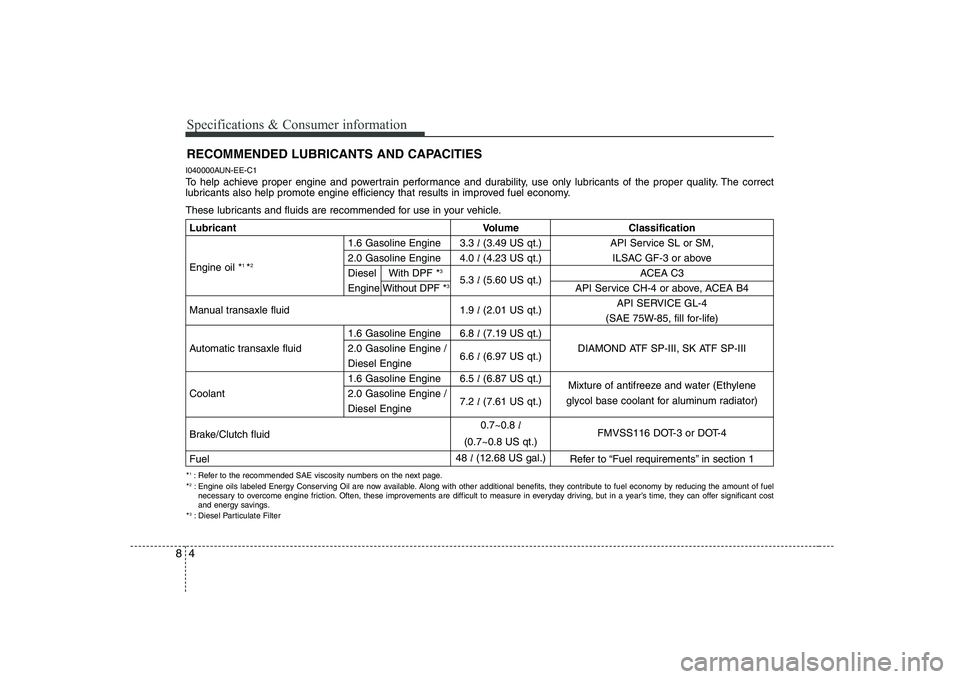
Specifications & Consumer information
4
8
RECOMMENDED LUBRICANTS AND CAPACITIES
I040000AUN-EE-C1
To help achieve proper engine and powertrain performance and durability, use only lubricants of the proper quality. The correct
lubricants also help promote engine efficiency that results in improved fuel economy.
These lubricants and fluids are recommended for use in your vehicle.
* 1
: Refer to the recommended SAE viscosity numbers on the next page.
* 2
: Engine oils labeled Energy Conserving Oil are now available. Along with other additional benefits, they contribute to fuel economy by reducing the amount of fuel
necessary to overcome engine friction. Often, these improvements are difficult to measure in everyday driving, but in a year’s time, they can offer significant cost
and energy savings.
* 3
: Diesel Particulate Filter
Lubricant Volume Classification
1.6 Gasoline Engine 3.3 l(3.49 US qt.) API Service SL or SM,
2.0 Gasoline Engine 4.0 l(4.23 US qt.) ILSAC GF-3 or above
Engine oil * 1
*2
Diesel With DPF *3
5.3 l(5.60 US qt.) ACEA C3
Engine Without DPF * 3
API Service CH-4 or above, ACEA B4
Manual transaxle fluid 1.9 l(2.01 US qt.) API SERVICE GL-4
(SAE 75W-85, fill for-life)
1.6 Gasoline Engine 6.8 l(7.19 US qt.)
Automatic transaxle fluid 2.0 Gasoline Engine / 6.6 l(6.97 US qt.) DIAMOND ATF SP-III, SK ATF SP-III
Diesel Engine
1.6 Gasoline Engine 6.5 l(6.87 US qt.)
Mixture of antifreeze and water (Ethylene
Coolant 2.0 Gasoline Engine / 7.2 l(7.61 US qt.)
Diesel Engine glycol base coolant for aluminum radiator)
Brake/Clutch fluid 0.7~0.8
l
FMVSS116 DOT-3 or DOT-4
(0.7~0.8 US qt.)
Fuel 48
l(12.68 US gal.)
Refer to “Fuel requirements” in section 1
Page 326 of 328
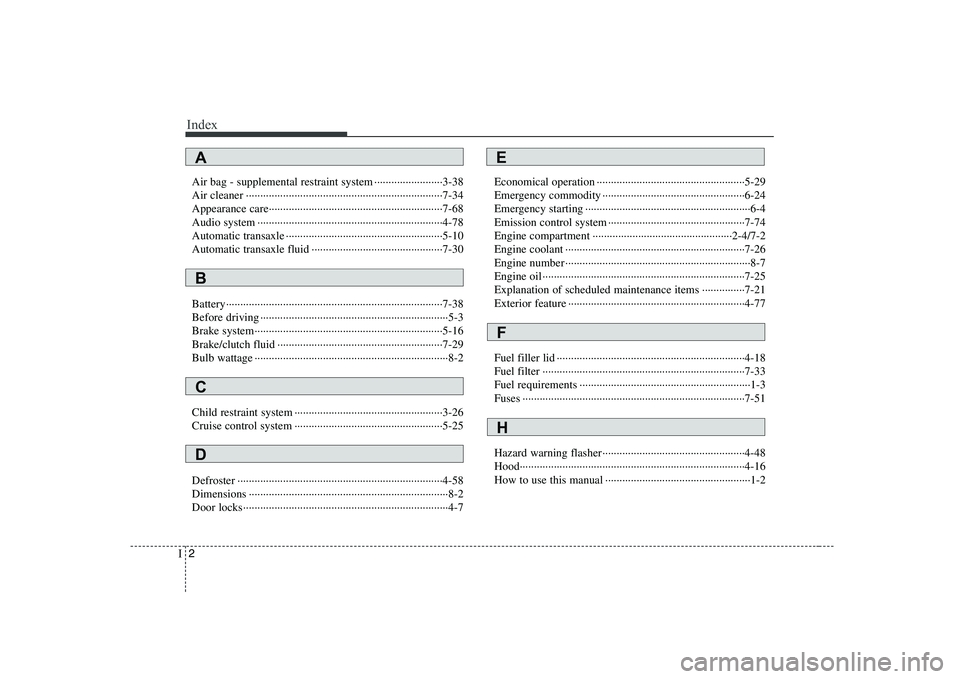
Index
2
I
Air bag - supplemental restraint system ························3-38
Air cleaner ·····································································7-34
Appearance care·····························································7-68
Audio system ·································································4-78
Automatic transaxle ·······················································5-10
Automatic transaxle fluid ··············································7-30
Battery············································································7-38
Before driving ··································································5-3
Brake system··································································5-16
Brake/clutch fluid ··························································7-29
Bulb wattage ····································································8-2
Child restraint system ····················································3-26
Cruise control system ····················································5-25
Defroster ········································································4-58
Dimensions ······································································8-2
Door locks········································································4-7 Economical operation ····················································5-29
Emergency commodity ··················································6-24
Emergency starting ··························································6-4
Emission control system ················································7-74
Engine compartment ·················································2-4/7-2
Engine coolant ·······························································7-26
Engine number ·································································8-7
Engine oil ·······································································7-25
Explanation of scheduled maintenance items ···············7-21
Exterior feature ······························································4-77
Fuel filler lid ··································································4-18
Fuel filter ·······································································7-33
Fuel requirements ····························································1-3
Fuses ··············································································7-51
Hazard warning flasher··················································4-48
Hood···············································································4-16
How to use this manual ···················································1-2
A
B
C
D
E
F
H